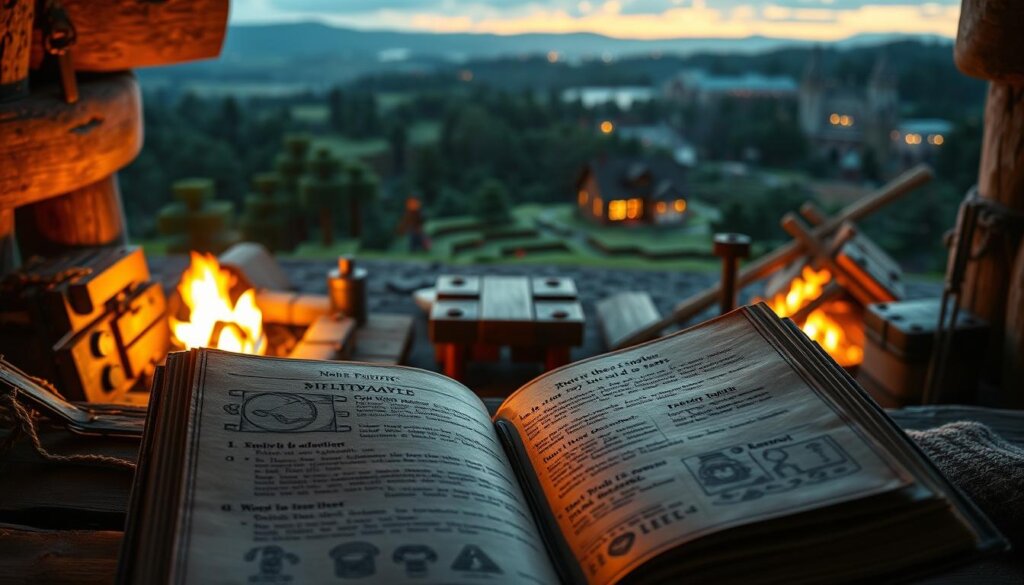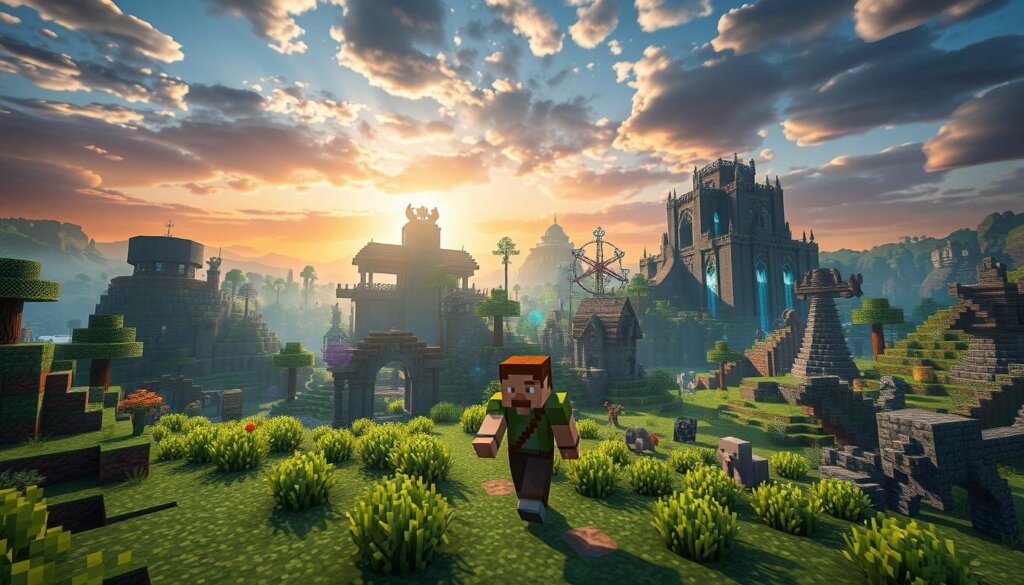Minecraft’s blocky world offers endless creativity, but players often seek ways to elevate its visuals. Shaders and texture packs transform the game’s appearance, adding realism without requiring high-end hardware. These tweaks make landscapes glow, water ripple, and shadows deepen.
The sandbox title thrives on customization. Players can install lighting overhauls or detailed textures to match their style. This flexibility keeps the experience fresh, even after years of play.
This guide explores 13 essential upgrades for 2024/2025. Each option works with Java Edition, though performance varies by setup. Combining multiple tweaks creates stunning results, from vibrant sunsets to lifelike foliage.
Introduction to Minecraft Graphics Mods
The default visuals of the game leave room for enhancement through creative customization. Whether aiming for realism or artistic flair, players can overhaul everything from lighting to surface textures. These tweaks breathe new life into familiar landscapes.
Why Use Visual Upgrades?
Shaders alter lighting, water, and shadows, adding depth without needing expensive hardware. They simulate natural effects like sunlight filtering through trees or raindrops glistening on surfaces.
Texture packs refine block details, elevating resolutions from 16×16 to 32×32 or higher. Some packs even introduce new blocks, expanding creative possibilities while keeping the original art style intact.
Shaders vs. Texture Packs
Shaders focus on dynamic effects, like realistic reflections and volumetric fog. They demand more processing power but transform the world’s ambiance instantly.
Texture packs upgrade static elements—bricks, grass, or ores—with sharper designs. They’re lighter on performance and work seamlessly alongside shaders for a complete visual overhaul.
Best Minecraft Shaders for Stunning Visuals
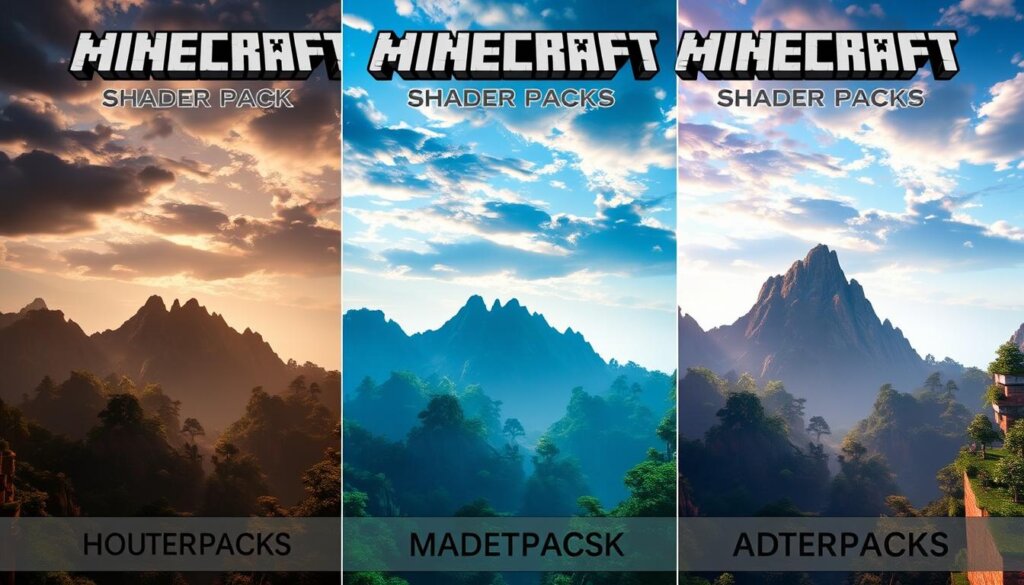
Visual upgrades can completely transform the look and feel of your gameplay. A shader pack modifies how light, shadows, and textures render, turning simple blocks into vivid landscapes. These tools use GLSL code to alter the game’s graphics pipeline, adding effects like realistic reflections and depth.
What Are Shaders and How Do They Work?
Shaders operate by rewriting how the game processes visuals. They introduce volumetric lighting, which makes sunlight scatter through leaves, and PBR materials for lifelike surfaces. Screen-space reflections add mirror-like water, while dynamic shadows create depth.
Performance varies widely. Lite versions work on older PCs, while extreme presets demand powerful hardware. For example, Sildurs offers tiers from “Enhanced Default” to “Extreme VL.” Always check the latest version for compatibility, especially with updates like 1.21.4.
Atmospheric touches elevate immersion. Some packs simulate raindrops on armor or improve night skies with detailed constellations. These subtle changes breathe new life into familiar biomes.
1. Bliss Shaders: A Fantasy Visual Overhaul
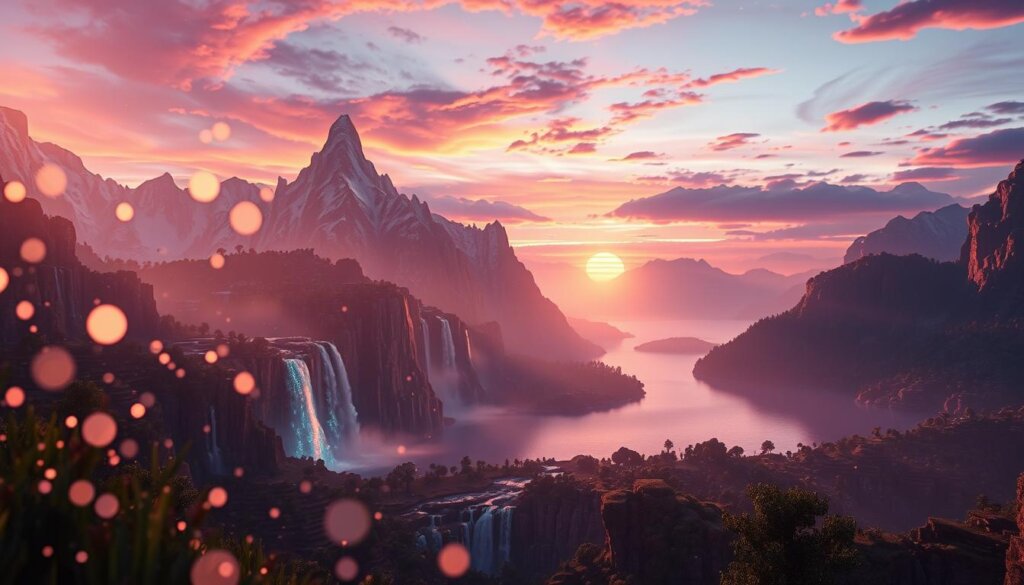
Step into a dreamlike realm with Bliss Shaders, where fantasy meets blocky landscapes. This shader transforms ordinary worlds into enchanted vistas, blending realism with whimsy. Its latest version (1.21.4) introduces mystical fog and dynamic storms, perfect for players seeking a surreal twist.
Immersive Features and Biome Magic
Bliss Shaders excels in biome-specific effects. Swamp biomes glow with an eerie green haze, while the End dimension swirls with void storms. Each environment feels alive, thanks to volumetric lighting and particle enhancements.
Performance is mid-range friendly. A GTX 1060 or equivalent handles most effects smoothly. For optimal results, pair it with a 32x texture pack to amplify the fantasy aesthetic.
2. Complementary Shaders Unbound: Customizable Lighting
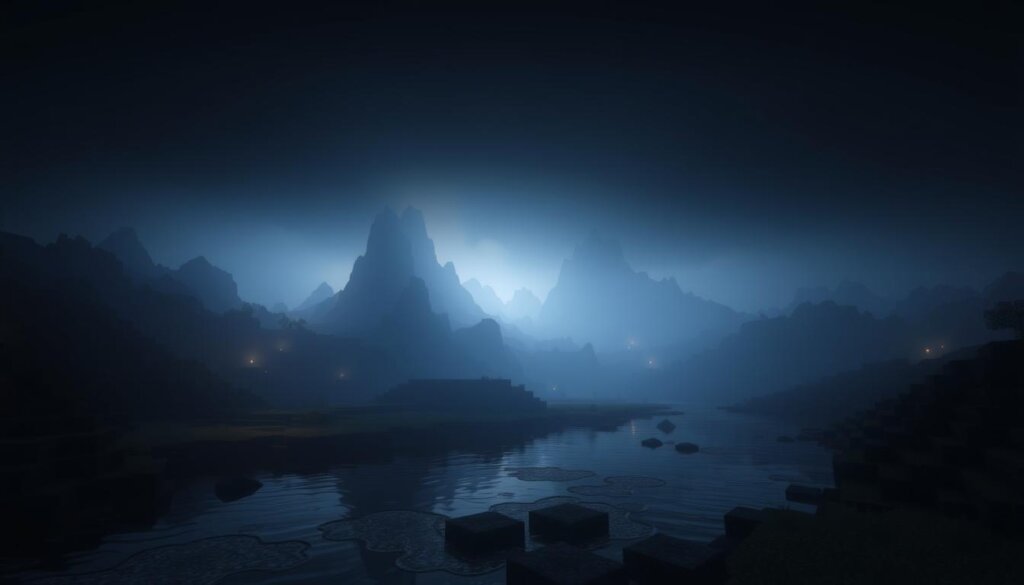
Shader packs like Complementary Unbound redefine lighting with precision. This pack offers two distinct variants—Unbound and Reimagined—each catering to different visual styles. Unbound leans into realism, while Reimagined preserves semi-vanilla charm.
Tailoring Your Visual Experience
The Unbound variant introduces dynamic color grading, letting players tweak hues for sunsets or interiors. Reimagined keeps closer to the default palette but enhances shadows subtly. Both support colored lighting, though GPU requirements vary.
For smoother performance, Iris mod is recommended over Optifine. Reducing render distance improves framerates without sacrificing shadow quality. Players can access advanced settings to balance visuals and performance effortlessly.
3. Sildurs Vibrant Shaders: Volumetric Lighting
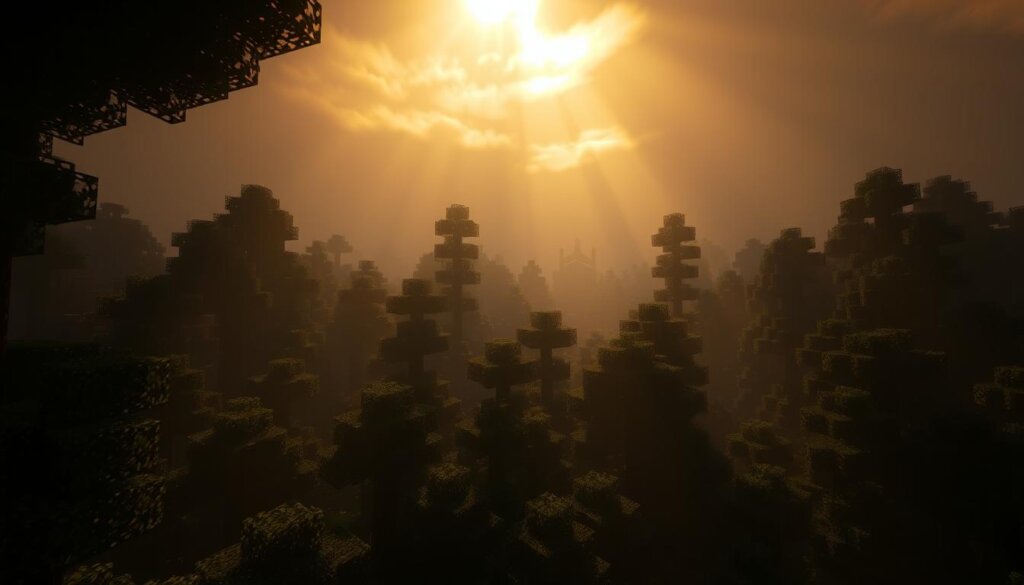
Sildurs Vibrant Shaders brings cinematic lighting to blocky landscapes. Its volumetric effects cast god rays through trees, creating dramatic sunbeams. Water reflections ripple realistically, while shadows adapt to the time of day.
Flexible Performance Tiers
This shader pack offers four presets to match hardware capabilities:
- Lite: Runs smoothly on integrated graphics (60+ FPS).
- Medium: Adds subtle depth of field for mid-range PCs.
- High: Enhances water reflections and shadow details.
- Extreme: Demands high-end GPUs for full volumetric fog.
The Extreme version includes dynamic weather effects, like rain distorting light on the screen. For balanced visuals, the Medium preset is ideal for most setups.
4. BSL Shaders: Realistic Atmosphere
BSL Shaders crafts a world where sunlight dances on water and shadows breathe. Its warm lighting palette mimics golden hour, casting a cinematic glow over landscapes. Subtle RTX-like effects add depth without demanding top-tier hardware.
Lighting and Water Effects
BSL’s lighting simulations are unmatched. Sunlight filters through leaves with subsurface scattering, making foliage feel alive. Oceans reflect light dynamically, with caustic patterns shimmering underwater.
The shader breathes life into biomes. Swamps exude misty ambiance, while deserts bask in intense heat haze. Pair it with POM texture packs for enhanced parallax surfaces—every block gains tactile realism.
- Golden hour magic: Sunset hues blend seamlessly into twilight.
- Performance-friendly: Mid-range GPUs handle most presets smoothly.
- Customizable: Adjust fog density or water clarity in settings.
5. SEUS PTGI: Ray Tracing Alternative
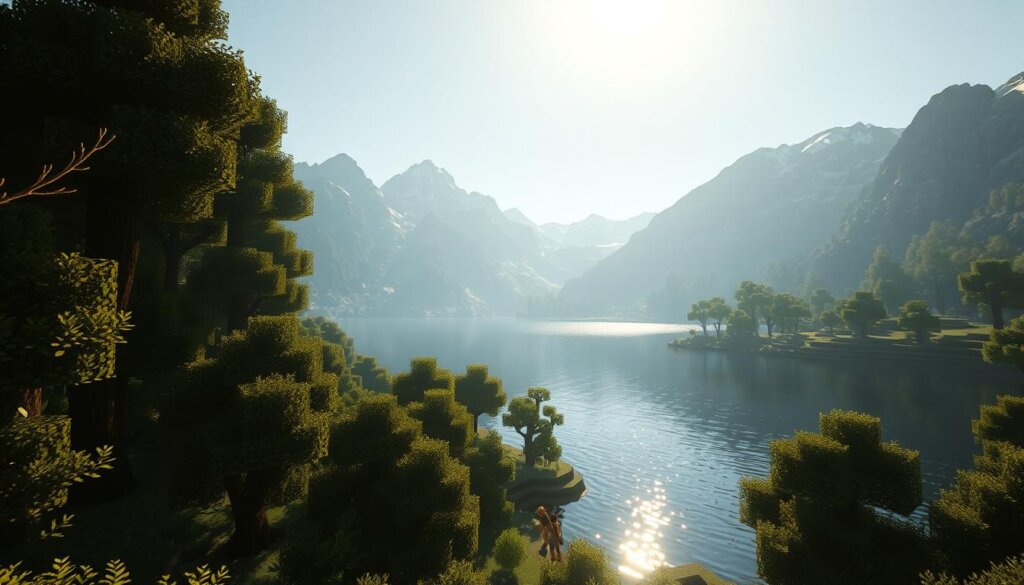
SEUS PTGI delivers cinematic realism through path-traced lighting, setting a new standard for visual fidelity. This shader replicates how light behaves in the real world, casting accurate shadows and reflections. Unlike traditional packs, it uses path-traced global illumination for lifelike ambiance.
Hardware Requirements and Visual Benefits
A GTX 1650 or higher GPU is recommended for smooth performance. The graphics overhaul includes:
- Path-traced global illumination: Light bounces naturally, creating soft shadows and vibrant colors.
- Rain-wet surfaces: Water droplets reflect light dynamically, altering the look of blocks during storms.
- Procedural clouds: Skies change organically throughout the day.
Compared to Minecraft RTX Beta, SEUS PTGI runs on broader hardware while achieving similar depth. However, night vision may appear overly bright—a known quirk. For optimal results, pair it with high-resolution textures.
Top Minecraft Texture Packs for Enhanced Blocks
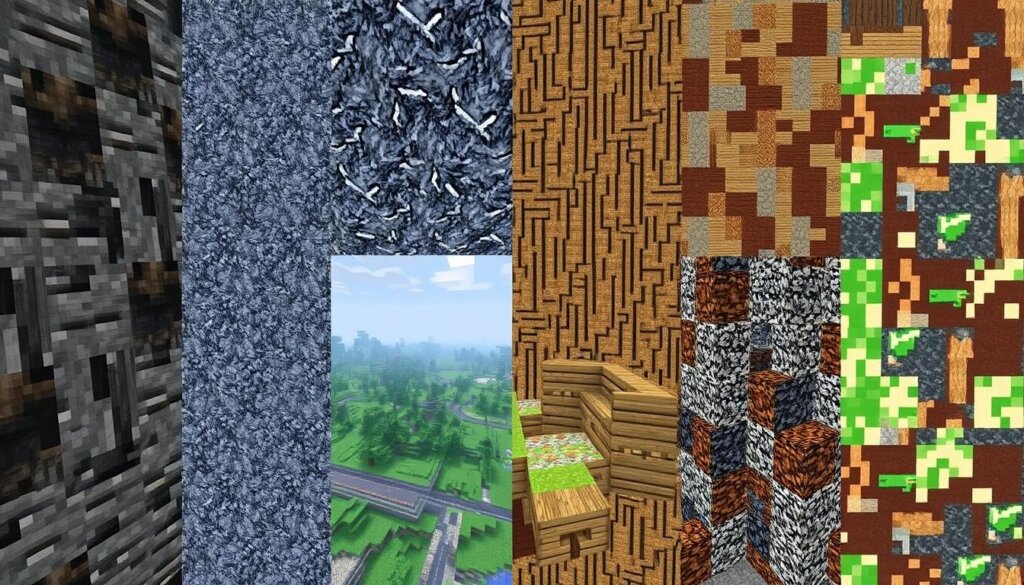
Block textures define the visual identity of every world, offering endless customization. Unlike shaders, which focus on lighting, texture packs refine surfaces—turning粗糙的石头 into polished marble or adding intricate carvings to wood.
How Texture Packs Change the Game
These packs overhaul the look Minecraft worlds by replacing default assets. Higher resolutions, like 32×32 or 512x, add crisp details without altering gameplay. Some packs introduce new blocks, such as Chipped’s 1,000+ variants for builders craving variety.
Advanced features elevate realism:
- PBR materials: Normal and specular maps make surfaces react to light dynamically.
- Connected textures: Cobblestone walls blend seamlessly, removing repetitive patterns.
- Seasonal swaps: Mods like Serene Seasons autoadjust foliage textures for winter or autumn.
Faithful 32×32 remains a staple, doubling vanilla resolution while keeping the original art style. For fantasy fans, packs like Mythic blend medieval and magical elements into every block.
6. Faithful: High-Resolution Vanilla
Faithful enhances the classic aesthetic with crisp, high-resolution textures. It preserves the vanilla art style while doubling the detail of default assets. Continuously updated since 2012, this pack remains a top choice for purists.
32×32 Texture Details
Every block gains clarity without losing its original charm. Cobblestone shows finer cracks, and wood grains appear more defined. Items like tools and armor also receive sharper surface details.
The GUI and HUD are cleaner, with readable fonts and icons. Add-ons extend support to modded blocks, ensuring consistency across expanded content. Side-by-side comparisons reveal subtle yet impactful upgrades.
- Biome-specific tweaks: Grass and leaves vary slightly by region.
- Connected textures: Walls and glass panes blend seamlessly.
- Optimized for performance, even at 32x resolution.
7. Optifine: Performance and Visual Boost
Optifine bridges performance and aesthetics, offering smoother gameplay alongside stunning visual tweaks. This mod doubles FPS while adding customizable lighting, making it a staple for players seeking balance.
Dynamic Lighting and Fog Control
Optifine’s lighting effects transform interiors and caves with real-time torch flickers. Players adjust fog density per biome, enhancing immersion without lag. The latest version refines these features for stability.
Key optimizations include:
- Entity shadows: Toggle shadows for mobs or items to reduce GPU load.
- Anisotropic filtering: Sharpens distant textures, ideal for vast landscapes.
- Lazy chunk loading: Prioritizes visible terrain, boosting FPS during exploration.
- Clear water: Replaces vanilla murkiness with transparent waves and reflections.
These tweaks make Optifine a critical part of any visual upgrade setup. It’s compatible with most shaders, letting players layer enhancements effortlessly.
How to Install Minecraft Mods for Better Graphics
Customizing your game with visual enhancements requires careful setup for optimal results. Whether adding shaders or texture packs, following the correct steps ensures smooth performance and stunning visuals.
Step-by-Step Guide for Optifine and Shaders
First, download Optifine or Iris from their official sites. These tools optimize performance while enabling shader support. Install them by double-clicking the .jar file—no manual folder placement is needed.
For shaders, locate the .shaderpacks folder in your game directory. Drag downloaded shader files here. Launch the game, navigate to Video Settings > Shaders, and select your preferred pack.
Compatibility Notes for Different Versions
Always match the version of your mods with the game. Optifine 1.21.4 won’t work with Minecraft 1.20. Fabric and Forge have different requirements—check mod descriptions before downloading.
- Fabric vs. Forge: Fabric is lighter but supports fewer mods. Forge offers broader compatibility.
- Iris vs. Optifine: Iris runs smoother with Fabric, while Optifine works standalone.
- Shader conflicts: Disable overlapping effects in settings to avoid crashes.
- Backup saves: Always list and copy worlds before installing new mods.
Elevate Your Minecraft World with These Visual Upgrades
Transforming blocky landscapes into breathtaking vistas has never been easier. Shaders like Bliss and BSL add depth, while texture packs refine every surface. Together, they redefine the game’s aesthetic without sacrificing performance.
Mid-range GPUs handle most upgrades smoothly. Opt for Sildurs’ Lite preset or Complementary’s customizable lighting. Seasonal textures—like autumn leaves or snowy biomes—keep worlds fresh year-round.
Future trends hint at smarter ray tracing and dynamic biomes. For now, these tools let players craft visually stunning realms effortlessly. Dive in and watch ordinary blocks become extraordinary.

